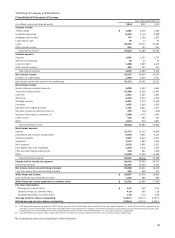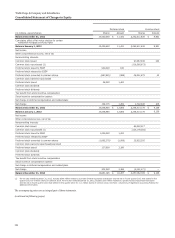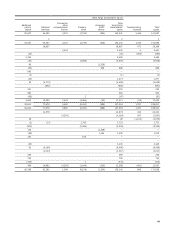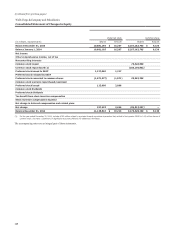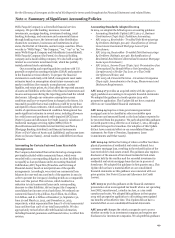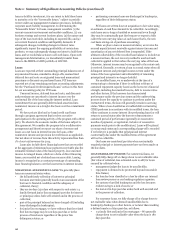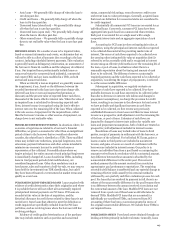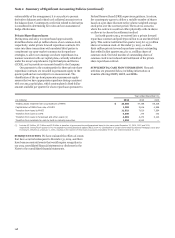Wells Fargo 2014 Annual Report Download - page 141
Download and view the complete annual report
Please find page 141 of the 2014 Wells Fargo annual report below. You can navigate through the pages in the report by either clicking on the pages listed below, or by using the keyword search tool below to find specific information within the annual report.
See the Glossary of Acronyms at the end of this Report for terms used throughout the Financial Statements and related Notes.
Note 1: Summary of Significant Accounting Policies
Wells Fargo & Company is a diversified financial services
company. We provide banking, insurance, trust and
investments, mortgage banking, investment banking, retail
banking, brokerage, and consumer and commercial finance
through banking stores, the internet and other distribution
channels to consumers, businesses and institutions in all 50
states, the District of Columbia, and in foreign countries. When
we refer to “Wells Fargo,” “the Company,” “we,” “our” or “us,” we
mean Wells Fargo & Company and Subsidiaries (consolidated).
Wells Fargo & Company (the Parent) is a financial holding
company and a bank holding company. We also hold a majority
interest in a real estate investment trust, which has publicly
traded preferred stock outstanding.
Our accounting and reporting policies conform with U.S.
generally accepted accounting principles (GAAP) and practices
in the financial services industry. To prepare the financial
statements in conformity with GAAP, management must make
estimates based on assumptions about future economic and
market conditions (for example, unemployment, market
liquidity, real estate prices, etc.) that affect the reported amounts
of assets and liabilities at the date of the financial statements and
income and expenses during the reporting period and the related
disclosures. Although our estimates contemplate current
conditions and how we expect them to change in the future, it is
reasonably possible that actual conditions could be worse than
anticipated in those estimates, which could materially affect our
results of operations and financial condition. Management has
made significant estimates in several areas, including allowance
for credit losses and purchased credit-impaired (PCI) loans
(Note 6 (Loans and Allowance for Credit Losses)), valuations of
residential mortgage servicing rights (MSRs) (Note 8
(Securitizations and Variable Interest Entities) and Note 9
(Mortgage Banking Activities)) and financial instruments
(Note 17 (Fair Values of Assets and Liabilities)) and income taxes
(Note 21 (Income Taxes)). Actual results could differ from those
estimates.
Accounting for Certain Factored Loan Receivable
Arrangements
The Company determined that certain factoring arrangements
previously included within commercial loans, which were
recorded with a corresponding obligation in other liabilities, did
not qualify as loan purchases under Accounting Standard
Codification (ASC) Topic 860 (Transfers and Servicing of
Financial Assets) based on interpretations of the specific
arrangements. Accordingly, we revised our commercial loan
balances for year-end 2012 and each of the quarters in 2013 in
order to present the Company’s lending trends on a comparable
basis over this period. This revision, which resulted in a
reduction to total commercial loans and a corresponding
decrease to other liabilities, did not impact the Company’s
consolidated net income or total cash flows. We reduced our
commercial loans by $3.5 billion, $3.2 billion, $2.1 billion,
$1.6 billion, and $1.2 billion at December 31, September 30,
June 30 and March 31, 2013, and December 31, 2012,
respectively, which represented less than 1% of total commercial
loans and less than 0.5% of our total loan portfolio. We also
appropriately revised other affected financial information,
including financial guarantees and financial ratios, to reflect this
revision.
Accounting Standards Adopted in 2014
In 2014, we adopted the following new accounting guidance:
• Accounting Standards Update (ASU) 2014-17, Business
Combinations (Topic 805): Pushdown Accounting;
• ASU 2014-14, Receivables - Troubled Debt Restructurings
by Creditors (Subtopic 310-40): Classification of Certain
Government-Guaranteed Mortgage Loans Upon
Foreclosure;
• ASU 2014-04, Receivables - Troubled Debt Restructurings
by Creditors (Subtopic 310-40): Reclassification of
Residential Real Estate Collateralized Consumer Mortgage
Loans upon Foreclosure;
• ASU 2013-11, Income Taxes (Topic 740): Presentation of an
Unrecognized Tax Benefit When a Net Operating Loss
Carryforward, a Similar Tax Loss, or a Tax Credit
Carryforward Exists; and
• ASU 2013-08, Financial Services - Investment Companies
(Topic 946): Amendments to the Scope, Measurement and
Disclosure Requirements.
ASU 2014-17 provides an acquired entity with the option to
apply pushdown accounting in its separate financial statements.
We adopted the guidance in fourth quarter 2014 with
prospective application. This Update did not have a material
effect on our consolidated financial statements.
ASU 2014-14 requires certain government-guaranteed
mortgage loans to be classified as other receivables upon
foreclosure and measured based on the loan balance expected to
be recovered from the guarantor. We early adopted this guidance
in fourth quarter 2014, effective as of January 1, 2014, through a
modified retrospective transition. Our adoption of this Update
did not have a material effect on our consolidated financial
statements. See Note 7 (Premises, Equipment, Lease
Commitments and Other Assets).
ASU 2014-04 clarifies the timing of when a creditor has taken
physical possession of residential real estate collateral for a
consumer mortgage loan, resulting in the reclassification of the
loan receivable to real estate owned. The guidance also requires
disclosure of the amount of foreclosed residential real estate
property held by the creditor and the recorded investment in
residential real estate mortgage loans that are in process of
foreclosure. We adopted this guidance in first quarter 2014. This
Update did not have a material effect on our consolidated
financial statements as this guidance was consistent with our
prior practice. See Note 6 (Loans and Allowance for Credit
Losses).
ASU 2013-11 provides guidance on the financial statement
presentation of an unrecognized tax benefit when a net operating
loss (NOL) carryforward, a similar tax loss, or a tax credit
carryforward exists. We adopted this guidance in first quarter
2014 with prospective application to all existing unrecognized
tax benefits at the effective date. This Update did not have a
material effect on our consolidated financial statements.
ASU 2013-08 changes the criteria companies use to assess
whether an entity is an investment company and requires new
disclosures for investment companies. We adopted this guidance
139




